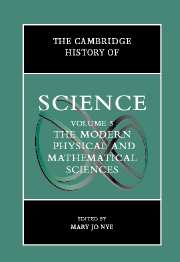Book contents
- Frontmatter
- Introduction: The Modern Physical and Mathematical Sciences
- Part I The Public Cultures of the Physical Sciences After 1800
- Part II Discipline Building in the Sciences: Places, Instruments, Communication
- Part III Chemistry and Physics: Problems Through the Early 1900s
- 11 The Physical Sciences in the Life Sciences
- 12 Chemical Atomism and Chemical Classification
- 13 The Theory of Chemical Structure and its Applications
- 14 Theories and Experiments on Radiation from Thomas Young to X Rays
- 15 Force, Energy, and Thermodynamics
- 16 Electrical Therory and Practice in the Nineteenth Century
- Part IV Atomic and Molecular Sciences in the Twentieth Century
- Part V Mathematics, Astronomy, and Cosmology Since the Eighteenth Century
- Part VI Problems and Promises at the End of the Twentieth Century
- Index
- References
13 - The Theory of Chemical Structure and its Applications
from Part III - Chemistry and Physics: Problems Through the Early 1900s
Published online by Cambridge University Press: 28 March 2008
- Frontmatter
- Introduction: The Modern Physical and Mathematical Sciences
- Part I The Public Cultures of the Physical Sciences After 1800
- Part II Discipline Building in the Sciences: Places, Instruments, Communication
- Part III Chemistry and Physics: Problems Through the Early 1900s
- 11 The Physical Sciences in the Life Sciences
- 12 Chemical Atomism and Chemical Classification
- 13 The Theory of Chemical Structure and its Applications
- 14 Theories and Experiments on Radiation from Thomas Young to X Rays
- 15 Force, Energy, and Thermodynamics
- 16 Electrical Therory and Practice in the Nineteenth Century
- Part IV Atomic and Molecular Sciences in the Twentieth Century
- Part V Mathematics, Astronomy, and Cosmology Since the Eighteenth Century
- Part VI Problems and Promises at the End of the Twentieth Century
- Index
- References
Summary
The theory of chemical structure was developed in the 1850s and 1860s, a product of the efforts of a number of leading European chemists. By the late 1860s it was regarded as a mature and powerful conceptual scheme that not only gave important insight into the details of molecular architecture in an invisibly small realm of nature, but also furnished heuristic guidance in the technological manipulation of those molecules, providing assistance in the creation of an important fine chemicals industry. The theory continued to develop in its power and subtlety throughout the following decades, until by the end of the century, it was by all measures the reigning doctrine of the science of chemistry, dominating investigations in both academic and industrial laboratories. Consequently, the story of the rise of this theory is an important component of the history of basic science, and also of the manner in which scientific ideas are applied to industry.
EARLY STRUCTURALIST NOTIONS
Speculations concerning geometrical groupings of the imperceptible particles that make up sensible bodies go back to the pre-Socratics. However, for our purposes, it is expedient to begin the story with the rise of chemical atomism, since structural ideas presuppose atoms in the modern chemical (post-Lavoisien) sense. The founder of the chemical atomic theory was John Dalton (1766–1844), and it is suggestive that immediately following the proposal of chemical atoms, Dalton and others began to speculate how they might be arranged into molecules (often then called “compound atoms”). As early as 1808 – about the time Dalton’s ideas first began to be known in the chemical community – William Wollaston was “inclined to think … that we shall be obliged to acquire a geometric conception of [the] relative arrangement [of the elementary atoms] in all the three dimensions of solid extension.”
- Type
- Chapter
- Information
- The Cambridge History of Science , pp. 255 - 271Publisher: Cambridge University PressPrint publication year: 2002
References
- 1
- Cited by



